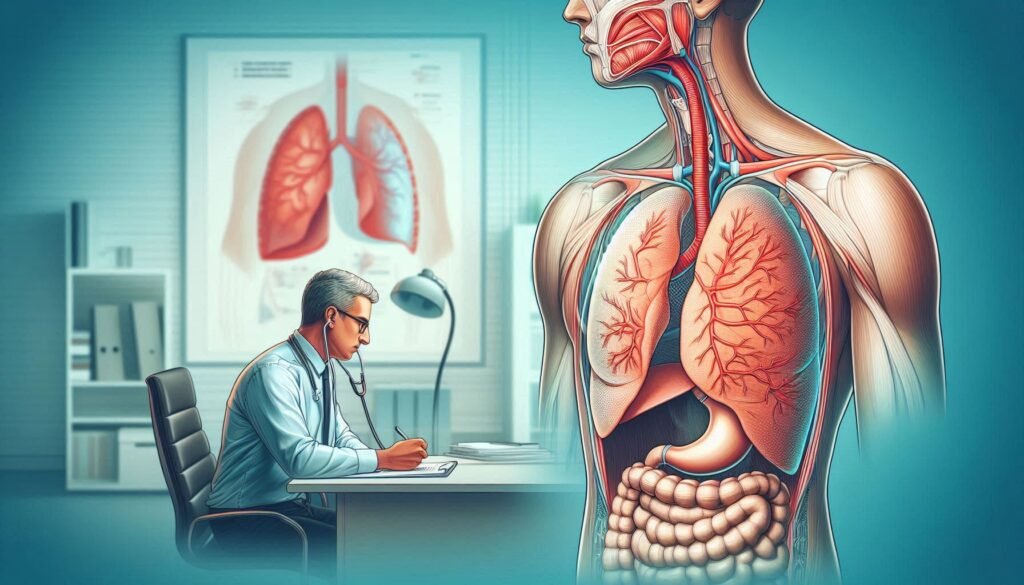Breathing is something we often take for granted. It happens automatically, and most of the time, we don’t even think about it. But what if your body’s main breathing muscle—the diaphragm—stops working effectively? This condition is known as diaphragmatic paralysis, and it can significantly impact your quality of life. From feeling short of breath to struggling with daily activities, understanding this condition is crucial not just for those affected but also for their loved ones.
In this blog post, we’ll delve into the ins and outs of diaphragmatic paralysis. We will explore its causes, symptoms, diagnosis methods, treatment options, and much more. If you want to empower yourself with knowledge about this often-overlooked respiratory issue or support someone who may be facing it, you’re in the right place! Let’s get started on unraveling the complexities surrounding diaphragmatic paralysis together.

What is Diaphragmatic Paralysis? Understanding the Basics
Diaphragmatic paralysis occurs when the diaphragm, the primary muscle responsible for breathing, becomes weak or unable to function. This condition can affect one side of the diaphragm (unilateral) or both sides (bilateral), leading to varying degrees of respiratory difficulty.
The diaphragm plays a pivotal role in inhalation by contracting and creating negative pressure within the thoracic cavity. When it’s paralyzed, this process is disrupted, resulting in shallow breathing and reduced oxygen intake.
“What Makes Pulmonary Edema Life-Threatening? Critical Signs”
Causes can range from nerve damage due to injury or surgery to diseases like ALS or poliomyelitis. Symptoms often manifest as shortness of breath, especially during physical activities or while lying flat.
Understanding diaphragmatic paralysis is essential for early diagnosis and effective management strategies that can enhance quality of life for those affected.
The Diaphragm’s Role: Why This Muscle is Crucial for Breathing
The diaphragm is a dome-shaped muscle located beneath the lungs. It plays a pivotal role in breathing by contracting and relaxing to facilitate airflow.
When you inhale, the diaphragm contracts, pulling downward and creating negative pressure in the thoracic cavity. This action allows air to flow into the lungs, filling them with oxygen-rich air.
“How Does Emphysema Progress? Understanding Lung Damage”
During exhalation, the diaphragm relaxes and moves back up into its original position. This pushes air out of the lungs as carbon dioxide-rich air is expelled from your body.
This muscle not only aids in respiration but also supports core stability. A well-functioning diaphragm enhances lung capacity and overall oxygen intake, vital for maintaining energy levels throughout daily activities. Understanding its function underscores why diaphragmatic paralysis can significantly affect health and quality of life.
Common Causes of Diaphragmatic Paralysis: From Injuries to Diseases
Diaphragmatic paralysis can occur due to various factors. Injuries are among the most prominent causes. Trauma to the neck or upper spine may lead to nerve damage affecting diaphragmatic function.
“What Makes Croup Different from Regular Coughs? Parent’s Guide”
Neurological conditions also play a significant role. Diseases like ALS, multiple sclerosis, and polio can disrupt signals from the brain that control diaphragm movement.
Additionally, infections can contribute to this condition. Viral infections such as shingles have been known to affect nerves responsible for diaphragm mobility.
Surgical procedures pose another risk factor. Certain surgeries on the chest or neck may inadvertently injure phrenic nerves.
Congenital issues should not be overlooked. Some individuals are born with anatomical abnormalities that impact their diaphragm’s ability to function effectively. Each of these causes highlights the complex nature of diaphragmatic paralysis and its origins.
Recognizing Diaphragmatic Paralysis: Key Symptoms to Watch For
Diaphragmatic paralysis can manifest in various ways, making early recognition vital. One primary symptom is shortness of breath, particularly during physical exertion. This may be accompanied by a feeling of chest tightness.
Patients often describe an unusual breathing pattern. You might notice shallow breaths or difficulty taking deep breaths. These changes occur because the diaphragm, your main muscle for inhalation, isn’t functioning properly.
“Why Does Central Sleep Apnea Happen? Understanding Brain Signals”
Another sign to watch for is a noticeable decrease in exercise tolerance. Activities that once felt easy may become exhausting and overwhelming.
Some individuals experience irregularities while sleeping too. Sleep disturbances can arise as breathing becomes labored at night.
If you observe any combination of these symptoms, it’s essential to consult with a healthcare provider promptly for evaluation and support.
Unilateral vs. Bilateral Paralysis: Understanding the Difference
Unilateral diaphragmatic paralysis affects only one side of the diaphragm. This condition can lead to reduced lung capacity on the affected side, often resulting in difficulty taking deep breaths. Patients may notice increased shortness of breath during physical activities.
“What is Pulmonary Alveolar Proteinosis? Complete Guide”
On the other hand, bilateral diaphragmatic paralysis involves both sides of the diaphragm. This more severe form significantly compromises respiratory function and can result in marked breathing difficulties at rest. Individuals with this condition may experience chronic fatigue or frequent episodes of breathlessness.
Understanding these differences is crucial for diagnosis and treatment options. Additionally, recognizing whether it’s unilateral or bilateral aids healthcare providers in tailoring management plans for optimal patient outcomes. Early recognition is essential for addressing symptoms effectively and improving quality of life.
Diagnosing Diaphragmatic Paralysis: Tests Your Doctor Will Perform
Diagnosing diaphragmatic paralysis involves a series of tests to assess diaphragm function. One common procedure is a physical examination, where your doctor evaluates breathing patterns and listens for abnormal lung sounds.
“How Does COPD Affect Daily Life? Management & Treatment”
Imaging techniques such as chest X-rays can reveal diaphragm position and movement. However, more advanced imaging like ultrasound or MRI offers detailed insights into muscle function, highlighting any paralysis.
Another essential test is pulmonary function testing. This assesses how well your lungs are performing by measuring airflow and gas exchange efficiency.
In some cases, nerve conduction studies may be conducted to evaluate the electrical activity in the phrenic nerve, which controls the diaphragm’s movements.
These diagnostic tools work together to provide a comprehensive understanding of diaphragmatic health and guide appropriate treatment plans tailored to individual needs.
The Impact on Daily Life: How Diaphragmatic Paralysis Affects You
Living with diaphragmatic paralysis can significantly alter daily activities. Breathing becomes more labor-intensive, leading to fatigue during simple tasks like walking or climbing stairs.
“What Are the Warning Signs of Pulmonary Embolism? Emergency Guide”
Physical exertion may leave individuals feeling winded or short of breath. This limitation affects not only personal fitness but also social interactions and outings.
Sleep quality often declines due to breathing difficulties at night, resulting in daytime drowsiness and decreased concentration levels. Activities requiring focus, such as studying or driving, may become challenging.
Emotional well-being can suffer too. Anxiety about breathing issues might lead to avoidance of physical activities or crowded spaces where panic could arise.
Daily routines may need adjustment, including pacing oneself throughout the day and planning rest breaks for recovery from exertion-related fatigue. Adapting to these changes requires resilience and support from family and friends for a fulfilling life despite the limitations imposed by this condition.
Treatment Options: From Conservative Approaches to Surgery
Treatment options for diaphragmatic paralysis vary widely depending on the severity and underlying cause of the condition. Conservative approaches typically include lifestyle adjustments, such as avoiding strenuous activities that could exacerbate breathing difficulties.
Some patients may benefit from respiratory therapies to enhance lung function. These can help improve oxygen intake and overall well-being without resorting to invasive measures.
When conservative methods fall short, surgical interventions may be considered. Surgical options can range from diaphragm plication to nerve repair procedures, aimed at restoring some level of diaphragm movement.
In specific cases, diaphragm pacing systems are also an option. These devices stimulate the phrenic nerve electrically, prompting contractions in the diaphragm itself. This innovative approach has shown promise for certain individuals facing significant challenges with their breathing related to diaphragmatic paralysis.
The Role of Physical Therapy in Managing Diaphragmatic Paralysis
Physical therapy plays a pivotal role in managing diaphragmatic paralysis. It focuses on restoring function and improving quality of life for affected individuals.
Therapists tailor exercise programs to strengthen respiratory muscles, enhancing overall lung capacity. Techniques often include breathing exercises that promote better oxygenation and reduce shortness of breath.
Education is another key aspect. Patients learn about proper posture and body mechanics, which can alleviate pressure on the diaphragm and facilitate easier breathing.
Manual therapy may also be utilized to release tension around the chest wall, further supporting respiratory function.
By incorporating specific stretches and strengthening routines, physical therapists help patients regain confidence in their ability to breathe effectively. This holistic approach empowers individuals to take control of their condition while fostering resilience against potential complications associated with diaphragmatic paralysis.
Breathing Exercises: Techniques to Improve Lung Function
Breathing exercises can significantly enhance lung function, especially for those dealing with diaphragmatic paralysis. These techniques focus on strengthening the diaphragm and improving overall respiratory efficiency.
One effective method is diaphragmatic breathing. This involves inhaling deeply through the nose, allowing your abdomen to rise as you fill your lungs fully. Exhale slowly through pursed lips, feeling your stomach fall. Repeat this several times to promote relaxation and oxygenation.
Another useful technique is pursed-lip breathing. Inhale deeply through the nose, then exhale slowly while keeping your lips tightly pressed together. This helps maintain open airways longer, making it easier to breathe out stale air.
Incorporating these exercises into daily routines can improve breath control and increase lung capacity over time. It’s essential to practice regularly for optimal benefits and consult a healthcare professional if any discomfort arises during exercise sessions.
Assistive Devices: When and How They Can Help
Assistive devices can significantly enhance the quality of life for individuals with diaphragmatic paralysis. These tools are designed to support breathing and improve daily activities.
One common device is a ventilator, which helps maintain airflow when natural breathing becomes difficult. It’s particularly beneficial during sleep or in emergencies.
Another option is a bi-level positive airway pressure (BiPAP) machine. This device provides varying levels of pressure while inhaling and exhaling, making it easier for patients to breathe comfortably.
Portable oxygen concentrators offer an alternative by supplying concentrated oxygen directly to the user. They allow greater mobility without sacrificing respiratory support.
Patients should consult their healthcare providers about the best fit for their situation. Personalized recommendations ensure that assistive devices cater specifically to individual needs, enhancing both independence and confidence in managing symptoms.
Living with Chronic Diaphragmatic Paralysis: Coping Strategies
Living with chronic diaphragmatic paralysis can be challenging, but there are effective coping strategies. First, focus on developing a strong support network. Friends and family can provide emotional and practical assistance.
Educating yourself about the condition is also beneficial. Understanding how diaphragmatic paralysis affects your body empowers you to make informed decisions regarding your health.
Incorporating breathing techniques into your routine can help manage symptoms. Methods such as pursed-lip breathing promote oxygenation and improve lung function over time.
Stay active within your limits by engaging in gentle exercises recommended by healthcare professionals. These activities maintain mobility while preventing muscle atrophy.
Consider joining support groups where individuals share experiences and advice on navigating daily challenges related to this condition. Sharing stories fosters resilience and connects you with others facing similar struggles.
Diaphragmatic Paralysis in Children: Special Considerations
Diaphragmatic paralysis in children presents unique challenges. The diaphragm, a key muscle for breathing, can be affected by congenital issues or nerve injuries. When this occurs in young patients, it may not show the same symptoms as in adults.
Children may experience difficulty with physical activities and fatigue more quickly than their peers. Parents should be vigilant about changes in their child’s breathing patterns during play or rest.
Diagnosis often involves imaging tests like X-rays or ultrasound to visualize diaphragmatic movement. Early intervention is crucial; specialized treatment plans can help manage symptoms effectively.
Support from pediatric specialists is essential for both the child and family. Tailored therapy programs aim to improve lung function and overall quality of life while addressing emotional aspects related to living with a chronic condition.
The Connection Between Sleep and Diaphragmatic Paralysis
Sleep plays a vital role in overall health, but for individuals with diaphragmatic paralysis, it becomes particularly challenging. The diaphragm is essential for effective breathing during sleep. When this muscle malfunctions, patients may experience disrupted sleep patterns.
Many people with diaphragmatic paralysis find themselves waking frequently due to breathlessness or discomfort. This can lead to insomnia and daytime fatigue.
Additionally, the body’s position while sleeping affects lung function. Lying flat can exacerbate breathing difficulties, making side or elevated positions more favorable.
Proper management of symptoms is crucial for enhancing sleep quality. Techniques such as using specialized pillows or adjusting room environments can make a significant difference.
Understanding this connection allows caregivers and healthcare providers to address both breathing issues and their impact on rest effectively. Prioritizing good sleep hygiene is especially important in managing the challenges posed by diaphragmatic paralysis.
Complications of Untreated Diaphragmatic Paralysis
Untreated diaphragmatic paralysis can lead to serious complications that affect overall health. One of the primary concerns is respiratory distress. As the diaphragm fails to function properly, breathing becomes shallow and inefficient.
This inefficiency can increase the risk of pneumonia due to inadequate ventilation in the lungs. When air exchange is compromised, fluid can accumulate, creating a breeding ground for infection.
Additionally, untreated cases may result in chronic fatigue and decreased physical endurance. The body struggles with oxygen supply, leading to tiredness during daily activities.
Weight loss or malnutrition may occur as well. Difficulty eating and increased effort during breathing often contribute to these issues over time.
Emotional challenges arise from living with constant breathlessness. Anxiety and depression are common among individuals experiencing severe symptoms without treatment options readily available.
Diaphragm Pacing: A High-Tech Solution for Some Patients
Diaphragm pacing is an innovative approach designed to assist individuals with diaphragmatic paralysis. This technique involves the use of a specialized device that stimulates the diaphragm through electrical impulses.
The device, often implanted surgically, mimics the body’s natural signals for breathing. By activating the diaphragm muscle, it enables patients to breathe more effectively and comfortably.
Many candidates for diaphragm pacing experience significant improvements in their respiratory function. This can lead to enhanced quality of life and greater independence in daily activities.
Patients typically undergo thorough evaluations before receiving this treatment option. These assessments ensure that they are suitable candidates based on their specific medical conditions and needs.
While not everyone with diaphragmatic paralysis will qualify for diaphragm pacing, it represents a promising advancement in respiratory care technology, offering hope to those struggling with breathing difficulties.
Natural Remedies: Can They Help with Diaphragmatic Paralysis?
Natural remedies can offer complementary support for those experiencing diaphragmatic paralysis. While they may not directly treat the condition, some options promote overall lung health and respiratory function.
Herbal supplements like mullein or lobelia have been traditionally used to aid breathing difficulties. These herbs may help soothe inflamed airways and improve airflow. However, it’s crucial to consult a healthcare professional before starting any new supplements.
Essential oils such as eucalyptus and peppermint can also be beneficial. Inhalation through aromatherapy might ease feelings of breathlessness by opening up air passages.
Incorporating a balanced diet rich in antioxidants—like fruits and vegetables—can strengthen your immune system. Staying hydrated is equally important for maintaining optimal lung function.
While these natural approaches provide some relief, they should never replace medical treatment or advice from your doctor regarding diaphragmatic paralysis management.
The Emotional Impact: Dealing with the Stress of Breathing Difficulties
Living with diaphragmatic paralysis can be challenging not only physically but also emotionally. The stress of dealing with breathing difficulties may lead to feelings of anxiety, frustration, or even depression. Many individuals find themselves constantly worried about their ability to breathe properly, which can affect daily activities and overall quality of life.
Support networks play a vital role in managing these emotional challenges. Connecting with friends, family, or support groups allows individuals to share their experiences and seek understanding from others who face similar struggles. Professional help through counseling or therapy can also provide valuable coping strategies.
Practicing mindfulness techniques such as meditation or deep-breathing exercises can empower those affected by diaphragmatic paralysis. These practices promote relaxation and help manage the anxiety that often accompanies respiratory issues.
Finding joy in small victories—like completing a simple task without feeling winded—can significantly improve one’s outlook on life. Celebrate progress and embrace each day as it comes; this mindset fosters resilience against the emotional toll that breathing difficulties impose.
Addressing both physical and emotional aspects is key for anyone facing diaphragmatic paralysis. By cultivating awareness of feelings and seeking appropriate support, individuals can navigate their circumstances more effectively while maintaining hope for improvement in their condition.


